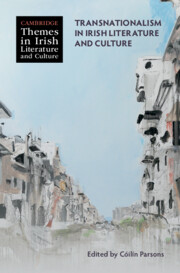495 results
4 - Ireland’s Accession to the League of Nations
-
- Book:
- An International Anomaly
- Published online:
- 23 March 2025
- Print publication:
- 03 April 2025, pp 125-178
-
- Chapter
-
- You have access
- Open access
- HTML
- Export citation

An International Anomaly
- Colonial Accession to the League of Nations
-
- Published online:
- 23 March 2025
- Print publication:
- 03 April 2025
-
- Book
-
- You have access
- Open access
- Export citation

Money and Irish Catholicism
- An Intimate History, 1850–1921
-
- Published online:
- 20 February 2025
- Print publication:
- 27 February 2025
10 - Minority Languages as Collateral Damage in the Climate Crisis: The Incidental Result of Ecoviolence on Y Gymraeg/Welsh Language
-
-
- Book:
- Ecoviolence Studies
- Published online:
- 13 February 2025
- Print publication:
- 20 February 2025, pp 170-182
-
- Chapter
- Export citation
4 - Americanisation in Irish Politics, c. 1850–1925
-
-
- Book:
- America in Ireland
- Published online:
- 09 January 2025
- Print publication:
- 23 January 2025, pp 94-119
-
- Chapter
- Export citation
Flexible Nationalisms: Applying Anthony D. Smith’s Theory to the Irish Case
-
- Journal:
- Nationalities Papers , FirstView
- Published online by Cambridge University Press:
- 23 January 2025, pp. 1-17
-
- Article
-
- You have access
- Open access
- HTML
- Export citation
Transnational Knowledge Circulation and the Closing of Minds to Progressive Education Influences on Schooling in the First Decade of Independence in Ireland
-
- Journal:
- History of Education Quarterly / Volume 65 / Issue 1 / February 2025
- Published online by Cambridge University Press:
- 22 January 2025, pp. 91-110
- Print publication:
- February 2025
-
- Article
-
- You have access
- Open access
- HTML
- Export citation
Chapter 5 - Ireland
- from Part I - Places
-
-
- Book:
- Gerard Manley Hopkins in Context
- Published online:
- 16 January 2025
- Print publication:
- 16 January 2025, pp 40-48
-
- Chapter
- Export citation
12 - Accessing Digital Evidence in Criminal Matters
- from Part II - Digital Evidence and the Cooperation of Service Providers in EU Criminal Investigations
-
-
- Book:
- The Cambridge Handbook of Digital Evidence in Criminal Investigations
- Published online:
- 02 January 2025
- Print publication:
- 09 January 2025, pp 309-346
-
- Chapter
- Export citation
The impact of the COVID-19 pandemic on first-episode psychosis presentations in two early intervention in psychosis services
-
- Journal:
- Irish Journal of Psychological Medicine , First View
- Published online by Cambridge University Press:
- 10 December 2024, pp. 1-8
-
- Article
-
- You have access
- Open access
- HTML
- Export citation
3 - Robert Montgomery
- from Part I - Rise of the Mediterranean Community
-
- Book:
- Three Consuls
- Published online:
- 31 October 2024
- Print publication:
- 21 November 2024, pp 68-93
-
- Chapter
- Export citation
Prevalence of self-harm among children and adolescents in the Republic of Ireland: a systematic review
-
- Journal:
- Irish Journal of Psychological Medicine / Volume 42 / Issue 1 / March 2025
- Published online by Cambridge University Press:
- 18 November 2024, pp. 71-84
- Print publication:
- March 2025
-
- Article
-
- You have access
- Open access
- HTML
- Export citation

Milton's Ireland
- Royalism, Republicanism, and the Question of Pluralism
-
- Published online:
- 14 November 2024
- Print publication:
- 12 December 2024

Transnationalism in Irish Literature and Culture
-
- Published online:
- 13 November 2024
- Print publication:
- 14 November 2024

The Citizen of the World
-
- Published online:
- 22 October 2024
- Print publication:
- 07 November 2024
Obituary: Professor Ivor Browne, FRCPI FRCPsych MSc (Harv.) DPM
-
- Journal:
- Irish Journal of Psychological Medicine / Volume 41 / Issue 4 / December 2024
- Published online by Cambridge University Press:
- 18 September 2024, pp. 423-426
- Print publication:
- December 2024
-
- Article
-
- You have access
- Open access
- HTML
- Export citation
The Library of the Honorable Society of King's Inns
-
- Journal:
- Legal Information Management / Volume 24 / Issue 3 / September 2024
- Published online by Cambridge University Press:
- 22 January 2025, pp. 143-152
- Print publication:
- September 2024
-
- Article
-
- You have access
- HTML
- Export citation
Researching Irish Legislation
-
- Journal:
- Legal Information Management / Volume 24 / Issue 3 / September 2024
- Published online by Cambridge University Press:
- 22 January 2025, pp. 157-161
- Print publication:
- September 2024
-
- Article
-
- You have access
- HTML
- Export citation
Irish Case Law Research
-
- Journal:
- Legal Information Management / Volume 24 / Issue 3 / September 2024
- Published online by Cambridge University Press:
- 22 January 2025, pp. 153-156
- Print publication:
- September 2024
-
- Article
-
- You have access
- HTML
- Export citation
8 - Parting the Unions
-
-
- Book:
- The Conservative Effect, 2010–2024
- Published online:
- 24 July 2024
- Print publication:
- 27 June 2024, pp 236-283
-
- Chapter
- Export citation


